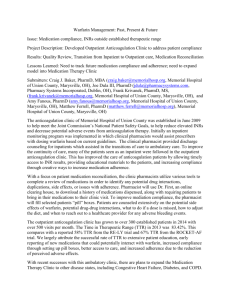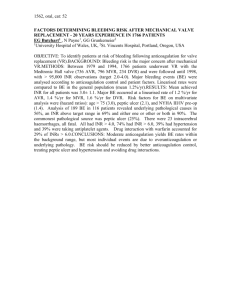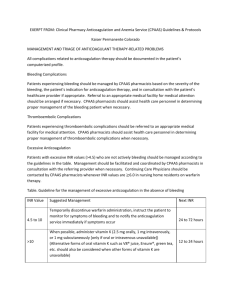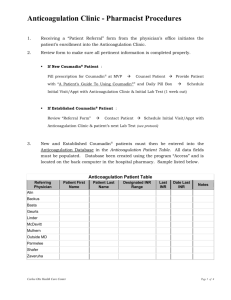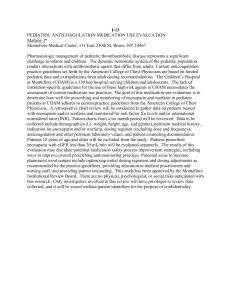Anticoagulation Protocol
advertisement
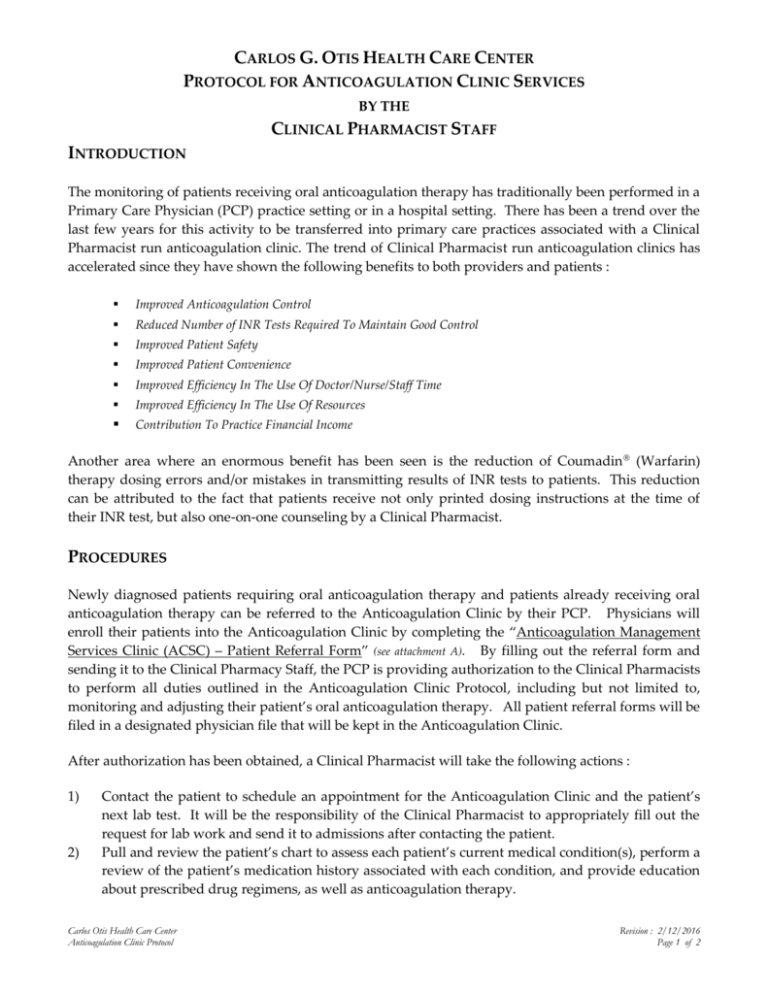
CARLOS G. OTIS HEALTH CARE CENTER PROTOCOL FOR ANTICOAGULATION CLINIC SERVICES BY THE CLINICAL PHARMACIST STAFF INTRODUCTION The monitoring of patients receiving oral anticoagulation therapy has traditionally been performed in a Primary Care Physician (PCP) practice setting or in a hospital setting. There has been a trend over the last few years for this activity to be transferred into primary care practices associated with a Clinical Pharmacist run anticoagulation clinic. The trend of Clinical Pharmacist run anticoagulation clinics has accelerated since they have shown the following benefits to both providers and patients : Improved Anticoagulation Control Reduced Number of INR Tests Required To Maintain Good Control Improved Patient Safety Improved Patient Convenience Improved Efficiency In The Use Of Doctor/Nurse/Staff Time Improved Efficiency In The Use Of Resources Contribution To Practice Financial Income Another area where an enormous benefit has been seen is the reduction of Coumadin (Warfarin) therapy dosing errors and/or mistakes in transmitting results of INR tests to patients. This reduction can be attributed to the fact that patients receive not only printed dosing instructions at the time of their INR test, but also one-on-one counseling by a Clinical Pharmacist. PROCEDURES Newly diagnosed patients requiring oral anticoagulation therapy and patients already receiving oral anticoagulation therapy can be referred to the Anticoagulation Clinic by their PCP. Physicians will enroll their patients into the Anticoagulation Clinic by completing the “Anticoagulation Management Services Clinic (ACSC) – Patient Referral Form” (see attachment A). By filling out the referral form and sending it to the Clinical Pharmacy Staff, the PCP is providing authorization to the Clinical Pharmacists to perform all duties outlined in the Anticoagulation Clinic Protocol, including but not limited to, monitoring and adjusting their patient’s oral anticoagulation therapy. All patient referral forms will be filed in a designated physician file that will be kept in the Anticoagulation Clinic. After authorization has been obtained, a Clinical Pharmacist will take the following actions : 1) 2) Contact the patient to schedule an appointment for the Anticoagulation Clinic and the patient’s next lab test. It will be the responsibility of the Clinical Pharmacist to appropriately fill out the request for lab work and send it to admissions after contacting the patient. Pull and review the patient’s chart to assess each patient’s current medical condition(s), perform a review of the patient’s medication history associated with each condition, and provide education about prescribed drug regimens, as well as anticoagulation therapy. Carlos Otis Health Care Center Anticoagulation Clinic Protocol Revision : 2/12/2016 Page 1 of 2 PROCEDURES 3) 4) 5) 6) (continued…..) Fill out and file in patient’s chart an “Initial Visit History and Checklist” form during the patient’s initial visit to the Anticoagulation Clinic (see attachment B). Counsel patient(s) receiving Coumadin (Warfarin) therapy regarding dietary restrictions, avoidance of aspirin and alcohol, drug-drug interactions, and activity precautions. Upon each visit to the Anticoagulation Clinic (designated per protocol), the INR test laboratory findings will be reviewed with each patient to verify that the appropriate therapeutic range has been attained and/or is being maintained. If required, adjustments to the patient’s Coumadin (Warfarin) dosing regimen will be handled according to protocol based on designated INR range assigned by physician’s order (see attachments C, D, E, & F). 7) 8) 9) 10) Fill out and update the “Anticoagulation Monitoring Flow Sheet” after each patient visit to the Anticoagulation Clinic (see attachment G). Each provider will designate the area of the patient’s chart to place this monitoring flow sheet for easy review and/or retrieval. Provide the Anticoagulation Clinic Medical Director with written notes of adjustments and/or changes to patient’s Coumadin (Warfarin) dosing regimen within 24 hours of the patients visit to the Anticoagulation clinic. These notes will then be forwarded to the PCP as soon as they are received back from the Clinic Physician. The PCP may request that the Clinical Pharmacist communicate to him or her all therapy changes as soon as possible (see attachments H). Once physician has reviewed the Clinical Pharmacists modifications to patients dosing regimen, the Adjustment Notification Form will be filed in patient’s chart accordingly. After notifying the physician, the Clinical Pharmacist may act as an authorized agent of the PCP/Medical Director, to write and fill prescriptions for Coumadin (Warfarin) for patients that need dosing adjustments &/or refills. Any and all prescription(s) for Vitamin K, should it be necessary, will be directed and discussed with the PCP/Medical Director before written and dispensed by the Clinical Pharmacist. Order all laboratory tests, including initial and follow up tests, for the use in the management of all patients on anticoagulation therapy. In the case of emergency, usual and customary Health Center procedure must be followed. Carlos Otis Health Care Center Anticoagulation Clinic Protocol Revision : 2/12/2016 Page 2 of 2
